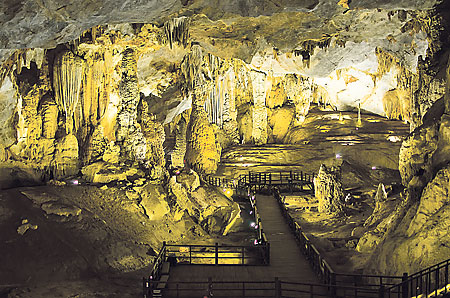
Angkor Wat, Cambodia
Located in the Northern province of Siem Reap and spanning over 400km2 is Angkor Archaeological Park, which contains the magnificent remains of the different capitals of the Khmer Empire from the 9th to the 15th Centuries.
One of them is Angkor Wat, consisting of an enormous temple pyramid surrounded by a moat. This grand towering monument can be considered the pinnacle of Khmer architecture, and is one of Southeast Asia’s most important archaeological sites.
Baroque Churches of the Philippines
These four Roman Catholic churches constructed between the 16th to 18th Centuries showcase the Chinese and Philippine craftsmen’s interpretation of the Baroque architectural style, with the fusion of European church design and construction with local materials as well as decorative motifs.
Two are located in the northern island of Luzon, one further south in the Visayas, and one in the middle of Manila. They had considerable influence on later church architecture, regionally.
Melaka and George Town, Malaysia
These two colonial towns are the most complete historic city centres on the Malaccan straits with a multi-cultural living heritage – their architectural and cultural townscape are unparalleled in East and Southeast Asia.
Having evolved from a small fishing village in the late 14th or early 15th Century into a trading port into the bustling city that it is today, Melaka is a centre of Peranakan culture, so it’s a must to visit the Baba and Nyonya Peranakan Museum.
George Town is an impressive surviving representation of the British era from the end of the 18th Century. Both are cities to experience a slice of life from a historic era in Southeast Asia.
Phong Nha–Ke Bang National Park, Vietnam
Vietnam is home to one of the world’s two largest, most outstanding karst (limestone) ecosystems, with 65km of caves and underground rivers in Phong Nha–Ke Bang National Park.
Massive tectonic changes have created a complex karst landscape with many geological features and spectacular formations. As a result visitors can get a visual treat of terraced, dry, suspended, dendritic [branching] and intersecting caves, as well as many endemic animal species.
Phong Nha–Ke Bang was initially a nature reserve, but has since been converted into a national park to protect aquatic habitats, primary and secondary forests, and rich species of flora and fauna.
Southeast Asia may not have certain historical or natural attractions such as those found in our Northern neighbours. Nonetheless, the varied, amazing UNESCO World Heritage sites that are available in these seven countries in our own backyard are still eye-openers, and definitely worth making a trip to discover.
ADVERTISEMENTS










Leave a Reply